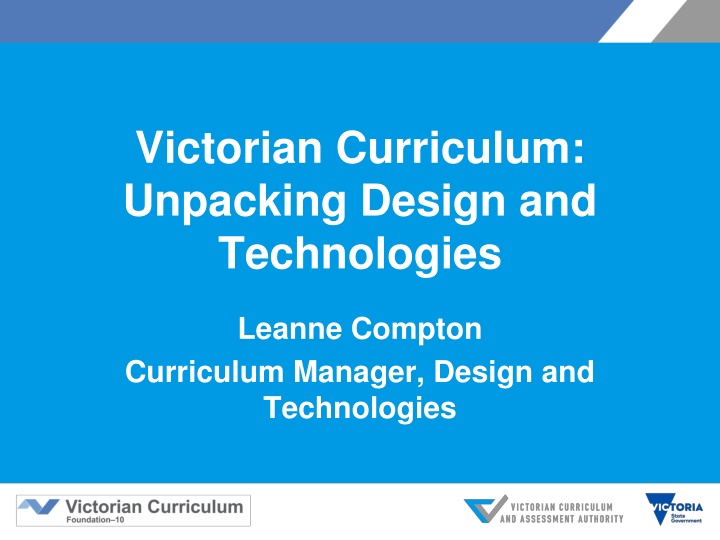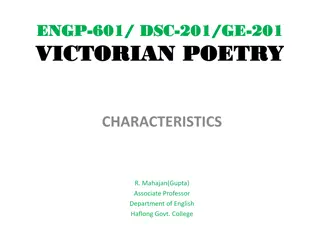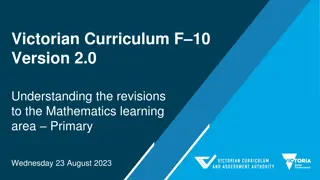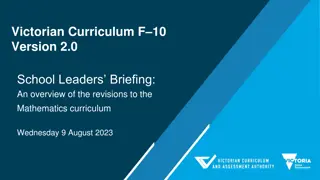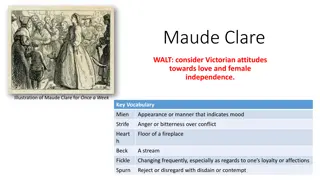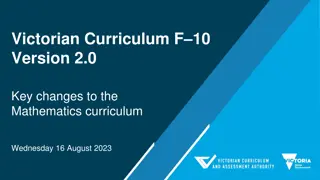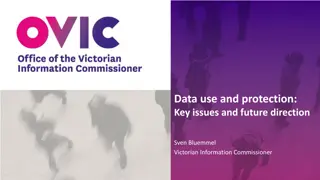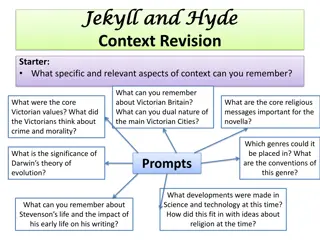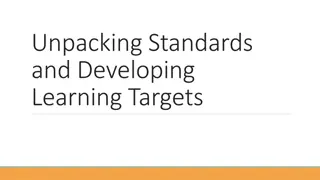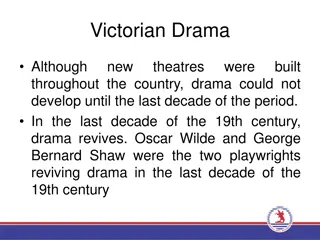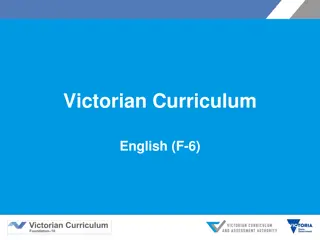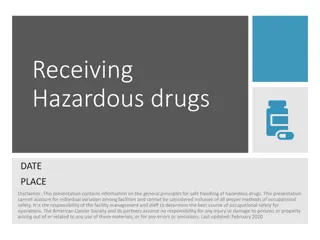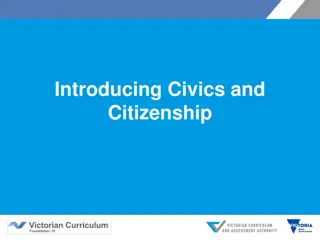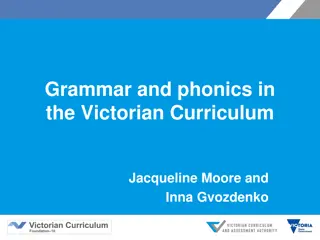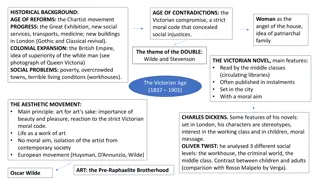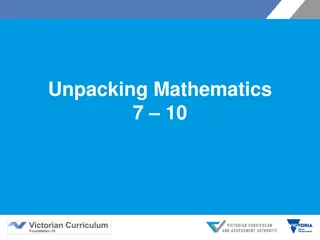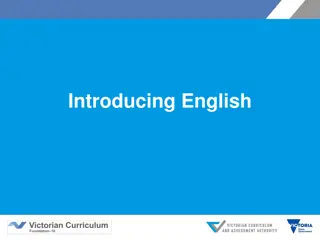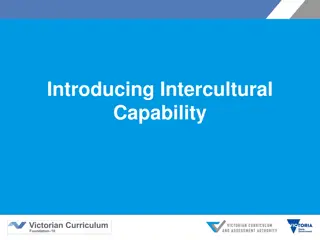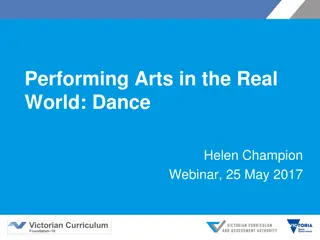Victorian Curriculum Unpacking Design
The Victorian Curriculum for Design and Technologies involves the implementation of new learning areas, including a focus on critical and creative thinking, ethics, and personal development. Schools have the flexibility to prepare for full implementation by 2017 while some may already be adopting the new curriculum. The Curriculum introduces components such as achievement standards, strands, and sub-strands, aiming to provide a structured approach to learning. Design and Technologies encompass creating designed solutions, technologies in society, and contextual applications.
Download Presentation

Please find below an Image/Link to download the presentation.
The content on the website is provided AS IS for your information and personal use only. It may not be sold, licensed, or shared on other websites without obtaining consent from the author.If you encounter any issues during the download, it is possible that the publisher has removed the file from their server.
You are allowed to download the files provided on this website for personal or commercial use, subject to the condition that they are used lawfully. All files are the property of their respective owners.
The content on the website is provided AS IS for your information and personal use only. It may not be sold, licensed, or shared on other websites without obtaining consent from the author.
E N D
Presentation Transcript
Victorian Curriculum: Unpacking Design and Technologies Leanne Compton Curriculum Manager, Design and Technologies
Victorian Curriculum F10 by 2017 Learning Areas The Arts o Dance o Drama o Media Arts o Music o Visual Arts o Visual Communication Design (7 10) English Humanities o Civics and Citizenship o Economics and Business o Geography o History Languages Health and Physical Education Mathematics Science Technology o Design and Technologies o Digital Technologies Capabilities Critical and Creative Thinking Intercultural Ethical Personal and Social
Timelines Implementation of the new Victorian Curriculum can commence in individual schools as soon as they choose, with all schools required to implement the new curriculum from the start of 2017. In other words, schools may be already implementing the curriculum now while others may be using 2016 to prepare for full implementation in 2017. 2013-16 From 2016 AusVELS curriculum available AusVELS website archived December 2016 Victorian Curriculum available Full implementation from 2017
Victorian Curriculum terminology AusVELS component Domains Dimensions ------- Learning focus Standards Victorian Curriculum Curriculum Areas Strands and sub-strands Content descriptions ------- Achievement standards
Components Introduction Rationale and Aims Curriculum Level/band descriptions Structure - Strands/sub-strands - Placement of standards Learning in Content Descriptions (+ elaborations) Achievement Standards Scope and Sequence Glossary
Where are the Achievement standards in Design and Technology? The first achievement standard at end of Level 2, and then at Levels 4, 6, 8 and 10. A curriculum for students with disabilities is provided in this learning area. The Level A - D continuum contains one content description for each strand. This provides greater flexibility to schools when developing their teaching and learning programs.
What is Design and Technologies? Technologies Design and Technologies Digital Technologies Three strands in Design and Technologies Creating Designed Solutions Technologies and Society Technologies Contexts
Considering the economic, environmental and social impacts of technological change and how the choice and use of technologies may contribute to a sustainable future Creating quality designed solutions across a range of technologies contexts What does Design and Technologies involve? Taking into account the ethical, legal, aesthetic and functional factors that inform the design processes
Creating Designed Solutions Based on design thinking, design processes and production processes typically addressed through a design brief Technologies and Society Focuses on how people use and develop technologies Design and Technologies involves students creating quality designed solutions across a range of technologies contexts Technologies Contexts Focuses on the characteristics and properties of four technologies contexts
Technologies and Society How people use and develop technologies Takes into account: economic, environmental, ethical, legal, aesthetic and functional factors impact of technologies on individuals, families, local, regional and global communities, and the environment.
Technologies Contexts Engineering principles and systems Materials and technologies Food and fibre production Food specialisations focuses on food and fibre as human-produced or harvested resources, and how food and fibre are produced in managed environments such as farms or plantations, or harvested from wild stocks. explores the application of nutrition principles and the characteristics and properties of food, food selection and preparation, and contemporary food issues explores a broad range of traditional, contemporary and emerging materials that involve an extensive use of technologies. explores how forces can be used to create light, sound, heat, movement, control or support in systems
Creating Designed Solutions Planning and managing Generating Producing Evaluating Investigating applying a variety of skills and techniques to make designed solutions to meet specific purposes and user needs learning to plan and manage time, along with other resources, to effectively create design solutions developing and communicating ideas for a range of audiences making judgements through a design process about the quality and effectiveness of designed solutions involves critiquing, exploring and investigating needs and opportunities
Creating Designed Solutions Production processes Design processes
Focus on different types of thinking Design thinking Use of strategies for understanding design needs and opportunities Systems thinking Generation of ideas and decisions made throughout the design processes; recognition of the connectedness and interactions Computational thinking Problem-solving used e.g. calculating costs, testing materials
Focus on sustainability Environmental Social Economic
Do I have to teach Design and Technologies every year? School-based decision as to when and how the Design and Technologies curriculum is delivered. More information is available in the Curriculum Planning and Reporting Guidelines: http://www.vcaa.vic.edu.au/Documents/viccurric/RevisedF- 10CurriculumPlanningReportingGuidelines.pdf
Contact Details Victorian Curriculum and Assessment Authority (VCAA) Leanne Compton Curriculum Manager, Design and Technologies compton.leanne.l@edumail.vic.gov.au phone: (03) 9032 1698
